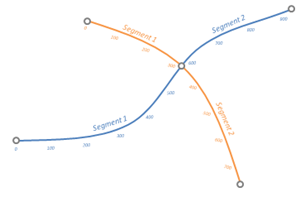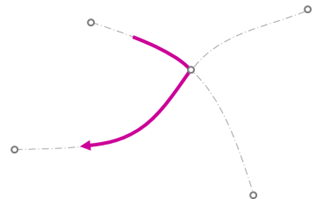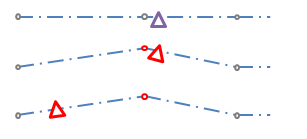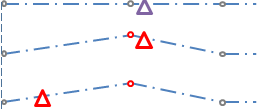Linear Referencing Systems (LRS) are widely used in transportation planning, where coordinate systems are not sufficient for pinpointing assets. A Linear Referencing System specifies a geographical feature (such as a road, railroad line, or river) as an axis and makes linear assets (such as street or route segments) and point assets (such as streetlights or city furniture) relative to that axis. Each asset can be described by its distance and offset from an axis.
Data analysts use a Linear Referencing System for managing and analyzing assets and events that occur along linear features. For example, an LRS can be used to analyze road conditions, lights, milestones, signs, traffic, accidents, and so on.
Your Administrator specifies feature classes for every part of an LRS, for example, axis, segment, asset, route, and route segment feature classes using Infrastructure Administrator. When you open a project that has been set up to use an LRS, you can create and assign features to the Linear Referencing System.
You can create any feature in a Linear Referencing System using standard creation commands (Display Manager, Document Manager, Electric Explorer, forms, and so on). You assign the features to the LRS later, using feature class forms. The effects of editing or deleting linear segments depend on options you set for the Linear Referencing System.
Elements of a Linear Referencing System

Axis
An axis is a linear reference that may have assets assigned to it and routes defined on it. Measures are defined on an axis basis. In practice, an axis is usually the centerline or alignment. An LRS model may represent a network that includes multiple axes.

Segment
A segment is a line feature that defines the geometry and measure of the axis. It can be configured to use a specific line feature in a particular LRS model.

Route
A route is a logically defined line feature that may cross multiple axes. Routes are not necessarily geometrically connected and can have gaps. In practice, a route could be a bus route, the shortest route from source to destination location, and so on.

Route Segment
A route segment is similar to axis segment, but it is part of a route (not an axis). It links to an axis segment or to part of one. It acts as a location-based line asset.
Offsets
Offset is the perpendicular distance of a point from the axis. It includes the following components:

- Side: The left/right side is defined as if you are facing the direction of the axis. In the system, side is represented by the sign of the distance value. You specify whether a positive value represents the left or right side.
- Offset: The offset from the referral measure point to the asset. It is always the perpendicular distance from the axis, except the direction is specified when the asset is in the inconclusive location. Note: The inconclusive location is a corner region in which the point is centered. The LRS uses the azimuth of the closest point to the asset in addition to the offset and measured values to handle this scenario.
- Direction (A in the figure): The direction is used to locate an asset only when the asset is in the inconclusive location. For general cases, the direction is NULL.
Assets
An asset is a feature assigned to an axis and can be located using linear referencing measure and offset. Point assets belong to Point feature classes. Line assets belong to LineString feature classes.
There are three types of assets:
- Static assets have a fixed geographic location and do not move along an axis.
- Location-based assets are located at a fixed geographical location along the axis.
- Measure-based assets are located at fixed measure values along the axis.
Asset Rotation
There are two types of asset rotation:
- Assets with a relative rotation type rotate automatically to align with the axis when the geometry of the underlying segments changes.

- Assets with an absolute rotation type keep their orientation when the geometry of the underlying segments changes.
